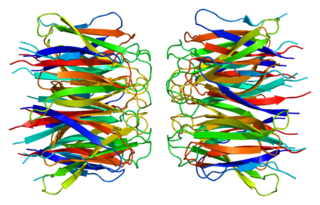
Nucleophosmin (NPM), also known as nucleolar phosphoprotein B23 or numatrin, is a protein that in humans is encoded by the NPM1 gene.

Receptor-binding cancer antigen expressed on SiSo cells is a protein that in humans is encoded by the EBAG9 gene.

DnaJ homolog subfamily A member 3, mitochondrial, also known as Tumorous imaginal disc 1 (TID1), is a protein that in humans is encoded by the DNAJA3 gene on chromosome 16. This protein belongs to the DNAJ/Hsp40 protein family, which is known for binding and activating Hsp70 chaperone proteins to perform protein folding, degradation, and complex assembly. As a mitochondrial protein, it is involved in maintaining membrane potential and mitochondrial DNA (mtDNA) integrity, as well as cellular processes such as cell movement, growth, and death. Furthermore, it is associated with a broad range of diseases, including neurodegenerative diseases, inflammatory diseases, and cancers.

60S acidic ribosomal protein P0 is a protein that in humans is encoded by the RPLP0 gene.

Serpin B3 is a protein that in humans is encoded by the SERPINB3 gene.

U4/U6.U5 tri-snRNP-associated protein 1 is a protein that in humans is encoded by the SART1 gene. This gene encodes two proteins, the SART1(800) protein expressed in the nucleus of the majority of proliferating cells, and the SART1(259) protein expressed in the cytosol of epithelial cancers. The SART1(259) protein is translated by the mechanism of -1 frameshifting during posttranscriptional regulation. The two encoded proteins are thought to be involved in the regulation of proliferation. Both proteins have tumor-rejection antigens. The SART1(259) protein possesses tumor epitopes capable of inducing HLA-A2402-restricted cytotoxic T lymphocytes in cancer patients. This SART1(259) antigen may be useful in specific immunotherapy for cancer patients and may serve as a paradigmatic tool for the diagnosis and treatment of patients with atopy. The SART1(259) protein is found to be essential for the recruitment of the tri-snRNP to the pre-spliceosome in the spliceosome assembly pathway.

60S acidic ribosomal protein P2 is a protein that in humans is encoded by the RPLP2 gene.

60S ribosomal protein L6 is a protein that in humans is encoded by the RPL6 gene.

Lymphocyte antigen 6E is a protein that in humans is encoded by the LY6E gene. Increased expression of Ly6E is associated with poor survival outcome in multiple malignancies as determined by a survey of more than 130 published clinical studies of gene expression studies on cancer tissue samples and adjacent normal tissues. Ly6E is associated with drug resistance and tumor immune escape in breast cancer. Further research is required to validate Ly6E for translation research.

Phosphatidylinositol binding clathrin assembly protein, also known as PICALM, is a protein which in humans is encoded by the PICALM gene.

Zinc finger protein 638 is a protein that in humans is encoded by the ZNF638 gene.

Probable ATP-dependent RNA helicase DDX41 is an enzyme that in humans is encoded by the DDX41 gene.

Heterogeneous nuclear ribonucleoprotein D-like, also known as HNRPDL, is a protein which in humans is encoded by the HNRPDL gene.

Ras-associated and pleckstrin homology domains-containing protein 1 is a protein that in humans is encoded by the RAPH1 gene.

PAS domain-containing protein 1 is a protein that in humans is encoded by the PASD1 gene.

Protein CIP2A also known as cancerous inhibitor of PP2A (CIP2A) is a protein that in humans is encoded by the KIAA1524 gene.

28S ribosomal protein S26, mitochondrial is a protein that in humans is encoded by the MRPS26 gene.

39S ribosomal protein L32, mitochondrial is a protein that in humans is encoded by the MRPL32 gene.

Transmembrane channel-like 8 is a protein which in humans is encoded by the TMC8 gene.

Tet methylcytosine dioxygenase 2 (TET2) is a human gene. It resides at chromosome 4q24, in a region showing recurrent microdeletions and copy-neutral loss of heterozygosity (CN-LOH) in patients with diverse myeloid malignancies.




















